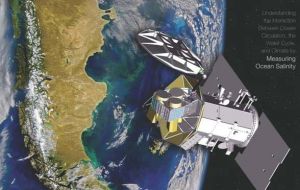MercoPress. South Atlantic News Agency
Argentine/NASA satellite will measure oceans' salt levels
 SAC-D Aquarius satellite
SAC-D Aquarius satellite Argentine and NASA scientists hope a new satellite will help them better track global climate change by measuring salt levels on the surface of the world's oceans.
Researchers from around the world on Thursday approved the final design of the satellite, which is slated to launch in 2010 and expected to provide new clues to help better predict shifts in climate. An ocean's salt level yields key information about the Earth's temperatures and ocean currents that may help scientists understand the effects of global warming. Experts currently measure salt levels manually, gathering samples at sea. However, the labor-intensive method means 24% of the ocean's surface has never been tested for salinity levels. The new SAC-D Aquarius satellite will measure salinity levels around the globe, once a month for three years. "We can't measure enough salinity from ships or buoys to get the climate predictions correct, so salinity measurement from space will transform some of our seasonal climate predictions," said NASA oceanographer Eric Lindstrom. Any swing in salinity levels could also reveal more clues about the behavior of ocean currents that in turn may signal drastic changes in climate, scientists say. Scientists are trying to determine the impact of global warming on constantly moving ocean currents, which act like a conveyor belt, helping to regulate temperatures by moving cold and warm water around the globe. Those currents can be altered if the ocean becomes less salty, and changes in ocean currents could affect climate patterns. For example, studies show reduced circulation related to salinity levels cooled the climate during the Ice Age. The satellite would study whether salinity levels have been affected, for example, by climate shifts in the northern hemisphere that have melted glaciers and increased rainfall, sending more fresh water into oceans. Argentine scientists designed the satellite, which includes high sensitivity cameras and solar panels, while NASA built the microwave radiometer that will do the measuring. The satellite will be assembled in Argentina.




Top Comments
Disclaimer & comment rulesCommenting for this story is now closed.
If you have a Facebook account, become a fan and comment on our Facebook Page!